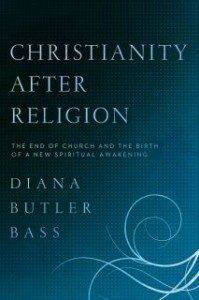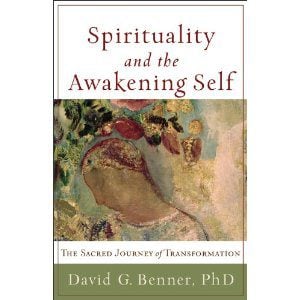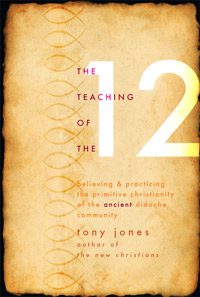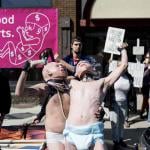The introductory post to this blog series is available here.
The highlights from Bass’ first two lectures are available here and here.
Borg’s first two lectures are here and here.
My musings on the lectures are in brackets.
Diana Butler Bass’ third and final lecture in the series was titled,
Great Awakening: Opening Our Eyes:
Who We Are, What We Can Do, and How Everything Can Change
Historical Survey
- The First Great Awakening began in 1720 (The phenomenon was named retrospectively in Beker Baerwald’s 1842 book The Great Awakening). From 1740 to 1770, the U.S. colonies radically changed in institution, outlook, and ideology. It was a massive cultural conversion experience. [Note that this movement was pre-Revolutionary War.]
- The Second Great Awakening (1800-1840).
- The Third Great Awakening (1880-1910) – characterized by both missionary activity and the Social Gospel movement.
- The Fourth Great Awakening started in the late 1960s) [parallels here with a book I reviewed recently titled, Mutants and Mystics].
What is an ‘Awakening’?
- NOT a brief emotional outburst or revivalism.
- See the categories in William G. McLoughlin’s Revivals, Awakenings, and Reform (Chicago History of American Religion). McLoughlin hypothesized that the Fourth Great Awakening would be a move away from understanding God as an omnipotent, death-dealing father toward a God, who is motherly as well as fatherly.
- IS a more extended period, involves a cultural revitalization movement, spans a generation or more, and includes a complete renewal of institutions of both church and state. A revival would be a “minor awakening,” not a Great Awakening [For related perspectives on the paradigm shift we are in the midst of, see Doug Pagitt’s work on The Inventive Age and Phyllis Tickle’s The Great Emergence.]
[Side note: In Cape Town last year, Richard Rohr said the following in response to a question from a Reformed minister about how he coped with being a free thinking priest in the Roman Catholic Church: “When a structure is collapsing you don’t have to push it.” When the laughter died down, he continued, “In fact, you shouldn’t even touch it, lest you be hit by the oppositional energy that is propping it up.”]
Where is the awakening?
- NOT: authoritarian, top-down, externally-based religious systems and institutions.
- IS: open, grassroots, internally-validated experiential faiths.
How does awakening happen?
- NOT: supernatural means or fiat.
- IS: pattern of personal and cultural change.
Process
- Individual Loss – isolated individual sense a problem and begin to dis-identify from the status quo.
- Distortion – individuals begin to realize they aren’t crazy. They begin to find one around and form a network or ‘tribe.’ Begin to realize that institutions and structures are failing ot meet demands of new cultural context. This is a dangerous period of deconstruction. OLD LIGHTS argue that we must go back to PAST (nativist backlash). Diagnose the problem as a need to return to past, to resist the intense pressure to change, progress, and evolve. They scapegoat someone or group as the troublemaker (for example, “We’re no longer faithful or effective as an institution or society because of Catholics…or African-Americans…or LGBT folk.”) And they promote the myth that if we could just get ride of this scapegoated group, then everything would return to ‘normal.’ Examples: KKK or some aspects of the Tea Party movement.
- New Vision: NEW LIGHTS see genuine set of paths toward FUTURE. The #Occupy protests are in the process of perhaps discerning a new path toward the future.
- Experimentation – Done by the youngest or most flexible members of society because they are the least invested in status quo [see my post on ““The Upside of Quitting”: Sunk Cost, Opportunity Cost, and the 10th Anniversary of the War in Afghanistan.“]
- Tipping Point – all those sitting on the fence decide whether to follow awakening or join a reactionary, counter-movement? [see Malcolm Gladwell’s book.]
- In 1980, we reset the above process in regard to The Fourth Great Awakening that began in the 1960s. Obama has picked up the process that halted with Carter and which Reagan interrupted [for example, taking down solar panels from White House, etc., which Obama put back up]. McLoughlin wrongly predicted that this whole process would tip in 1978.
For more details on each of these bullet-points, you can pre-order Bass’ forthcoming book Christianity After Religion: The End of Church and the Birth of a New Spiritual Awakening, which is scheduled to be released on February 14, 2012:
Stay tuned for the final installment on the highlights of Marcus Borg’s third lecture in the series.
The Rev. Carl Gregg is a trained spiritual director, a D.Min. candidate, and the pastor of Broadview Church in Chesapeake Beach, Maryland. Follow him on Facebook (facebook.com/carlgregg) and Twitter (@carlgregg).

















